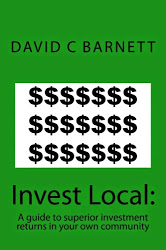 Business evaluator and private finance investor David Barnett recently sent me his new book Invest Local: A guide to superior investment returns in your own local community.
Business evaluator and private finance investor David Barnett recently sent me his new book Invest Local: A guide to superior investment returns in your own local community.
By taking readers through his real life examples and numbers in local small business financing, private lending and leasing, Barnett offers some straightforward, actionable ideas that individuals can consider doing with a controlled portion of their investment savings.
In an era where unethical, sneaky, unfair practices have made modern banks the frequent enemy of honest, hard-working people everywhere, putting the old-fashioned trust, and personal accountability (the three C’s of credit: character, capital and capacity) back into the borrowing and lending relationship is a refreshing idea. As Barnett puts it (p.148):
“Bringing financial service relationships back between individuals is important for building stronger local economies and communities. Banks and other financial institutions take millions of dollars out of our towns and cities each year in the form of interest and fees. By doing your own deals, you can keep some of that money in your community. When those profits are in your pocket and you spend the money locally, everyone around you benefits through job creation and increased job security.”
In my own lifetime I have borrowed and lent privately, bought and sold cars and real estate privately as well as been a landlord at different times to both residential and commercial tenants. In my experience, the best opportunities are always fairly-priced and offer good value to both sides of the transactions.
Of course there is capital risk in everything and private deals take some work, worry and care. It is not for those who are not interested in details and ongoing management. As in any investing, there is no free lunch and every venture comes with risk. But for those who are open to eye to eye dealings with people and are willing to do some work, the book offers some well-reasoned, practical ideas to consider.
On the other hand, a wise man once said “neither a borrower nor a lender be.” Each person must find solutions that suit their own temperament and risk tolerance.


